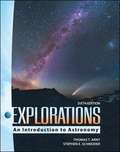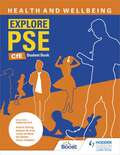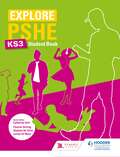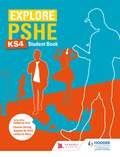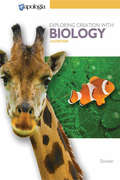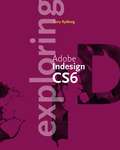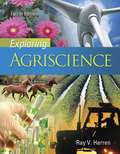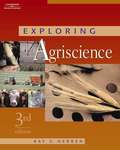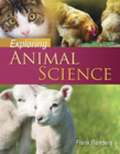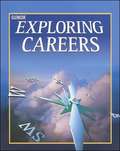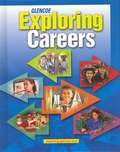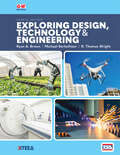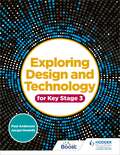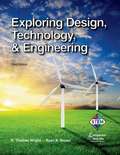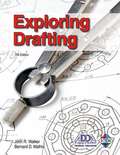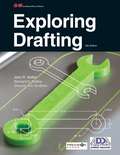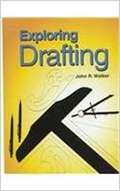- Table View
- List View
Explorations: An Anthology of Literature, Volume A
by John HoldrenA list of the pieces in this book. Stories of Our Time � Thank You, M'am Langston Hughes � The Circuit Francisco Jimenez � The Bracelet Yoshiko Uchida � To Everything There Is a Season � Waiting Harry Behn � Something Told the Wild Geese Rachel Field � Six Haiku translated by Harry Behn � Check James Stephens � The Pasture Robert Frost � A Wintry Sonnet Christina Rossetti � The Morns Are Meeker Than They Were Emily Dickinson � The Storm Walter de la Mare � Swift Things Are Beautiful Elizabeth Coatsworth � I Wandered Lonely as a Cloud William Wordsworth � Until I Saw the Sea Lilian Moore � "To everything there is a season" King James Bible Stories of Scientists � Michael Faraday's World Nancy Veglahn � Nikola Tesla, Inventor Shawn Lake � Healing a Wounded Heart: Daniel Hale Williams William Orem � Marie Curie and the Discovery of Radioactivity Mara Rockliff � Enrico Fermi: The "Italian Navigator" Dorothy Haas Advice and Instruction � The Fish I Didn't Catch John Greenleaf Whittier � Work John Ruskin � Honest Work � For Want of a Horseshoe Nail adapted from James Baldwin � Argument Joseph Addison � If Rudyard Kipling � Can't Edgar Guest � Letter to His Son Robert E. Lee � Mother to Son Langston Hughes � Perseverance Johann Wolfgang von Goethe � Rebecca Hilaire Belloc � The Story of Augustus Heinrich Hoffmann
Explorations: An Introduction to Astronomy
by Thomas T. Arny Stephen E. Schneider6th Edition Explorations: An Introduction to Astronomy is built on the foundation of its well known writing style, accuracy, and emphasis on current information. Accessible writing style allows coverage of technically complex ideas without confusing students.
Explore PSE: Health and Wellbeing for CfE Student Book
by Ian Geddes Calum Campbell Stephen De Silva Pauline Stirling Lesley de MezaSyllabus: CfE (Curriculum for Excellence, from Education Scotland) and SQALevel: BGE S1-3 (Second, Third and Fourth Levels), National 4 and National 5Subject: PSE (Health and Wellbeing)Empower Scotland''s young people to feel prepared for the opportunities and challenges of adult life.Exploring topics such as mental health, sex, identity, community and planning for your future, this book develops students'' life skills, knowledge and resilience as they learn about themselves and others.> Create a supportive environment where sensitive issues can be discussed confidently and constructively, using the book to provide stimulus material and structure> Follow an active learning approach with starter activities to get students thinking, visual sources and written extracts to encourage conversations, and hundreds of activities for individual, pair and group work> Monitor students'' progress through learning outcomes for each lesson/series of lessons and numerous activities that create opportunities for assessment for learning and evidence of achievement> Suit your students and your timetable, with topics that can be covered in any order and double-page spreads that can be delivered across one or two lessons> Rest assured that all content in the book is linked to the CfE Benchmarks and Experiences & Outcomes for Health and Wellbeing: Personal and Social Education, as well as the GIFREC and SHANARRI principles
Explore PSHE for Key Stage 3 Student Book
by Stephen De Silva Pauline Stirling Lesley de MezaDevelop your students' skills and understanding of PSHE and encourage an active learning approach, all whilst providing essential coverage of the 2020 statutory guidelines.The flexible design of this KS3 student book is compatible with whichever way your school delivers PSHE. User-friendly for both experienced PSHE Leads and for non-specialist teachers, it is packed full lesson outcomes and starter sections, as well as lot of activities students can get involved in.- Provide the right level of knowledge and understanding of PSHE education students need with this KS3 Student Book that has topic suitability for this age range- Learning outcomes at the start of every lesson, along with a short activity to introduce students to the topic and get them thinking provides an easy way in to every lesson- Source-based activities support an activity-based learning scheme that is accessible to students of all abilities
Explore PSHE for Key Stage 4 Student Book
by Philip Ashton Stephen De Silva Lesley de MezaDevelop your students' skills and understanding of PSHE and encourage an active learning approach, all whilst providing essential coverage of the 2020 statutory guidelines.The flexible design of this KS4 student book is compatible with whichever way your school delivers PSHE. User-friendly for both experienced PSHE Leads and for non-specialist teachers, it is packed full lesson outcomes and starter sections, as well as lot of activities students can get involved in.- Provide the right level of knowledge and understanding of PSHE education pupils need with this KS4 Student Book that has topic suitability for this age range.- Learning outcomes at the start of every lesson, along with a short activity to introduce students to the topic and get them thinking provides an easy way in to every lesson - Source-based activities support an activity-based learning scheme that is accessible to students of all abilities
Exploring Creation with Biology
by Vicki DincherAs scientific studies advance farther out into the universe as well as deeper into the microscopic world, scientists continue to ask, “What is life?” Biology is the study of life, and this 3rd edition of Exploring Creation with Biology teaches not only the science of how we begin to answer the bigger questions defining life, but also includes meaningful discussions on Creation and Creator. <p><p> This updated high school biology course was redesigned to help students see and understand the beauty of life that surrounds us. Full-page infographics were created to help students grasp the concepts discussed in the text and go beyond simple illustrations. <p> As a college-prep high school biology course, it will set the stage for success in homeschooled high school years, prepare students for college level courses, and give them an understanding of the basic biological world that surrounds them each day of their lives so that they can appreciate the real-world relevance of scientific inquiry. <p> Opening with the studies of the process of science, students learn about observations and inferences, hypotheses, experiments, and scientific theories and laws. They are taught to see the limitations of science and learn about the tools used in biological studies. <p> In their studies of life, students will delve into the chemistry of life from atoms to the chemical structures that make life, as we know it, possible. They will explore the ecology that surrounds life as they investigate ecosystems, biomes, populations, and communities. <p> An in-depth study of cell structure and function, cellular energy, DNA, proteins, and cell cycles will help students comprehend heartier materials as they advance to learn about genetics – inheritance, disorders, and technology, as well as the role of genetics in evolution. <p> Students will also learn about prokaryotes, viruses, protists, and fungi. They will delve deep into the fascinating world of plants and animals. And all of their learned knowledge will be backed by hands-on experimentation that takes their book knowledge and applies it to concepts that they can comprehend. <p> At Apologia, we believe that students’ educations should prepare them for life, not just an academic year. This creation-based science course will create the strong foundation students can rely upon as they grow in their awe and wonder of our world. <p> At the completion of this course, students will be able to understand the vocabulary of biology so that they can engage in true scientific discourse. Their strong background in the scientific method regarding experimentation, field studies, microscopy, and dissection will also allow them to be well equipped to analyze data that they will encounter throughout their lifetimes.
Exploring Adobe InDesign CS6
by Terry RydbergWith many software guides serving as high-tech "recipe books," teaching cookie-cutter habits with little relevance to complex, real-world projects, EXPLORING ADOBE INDESIGN CS6 takes a different approach. Emphasizing on fundamental design principles, critical thinking skills, and practical applications to prepare you for professional success, this unique text features step-by-step tutorials, vibrant illustrations, and realistic exercises to engage your interest while helping you develop essential software skills. Each chapter builds on what you have learned, guiding you from exploring basic operations to creating complex documents with confidence and efficiency. In addition to mastering InDesign CS6--including standard functionality and features new to this release--the text prepares you to analyze new design projects, identify potential challenges, develop effective strategies, and apply industry-standard principles and practices to execute your plans successfully. The Data Files used to complete the projects found in the book are now available online. For access information please refer to the directions available in the preface of the book.
Exploring Agriscience, 3rd Edition
by Ray V. HerrenExploring Agriscience, third edition, is a middle school text for students in Agricultural Education Programs who are enrolled in their first agriculture or agriscience class. Contents center on an exploration of agricultural industry as well as an explanation of how science concepts are used in agriculture. Topics covered include The history of agriculture; Soils, Plant structures; Entomology; Floriculture; Nursery and Landscaping; Fruit and Nuts; Row crops; Forestry; The Environment; Organic agriculture; Animal Science (including Dairy and Poultry); Aquaculture; Companion Animals; Ethics; Biotechnology; Careers; Agricultural Mechanics; Food Science; and Agricultural Education Programs. The text is illustrated with full color images that help clarify text material. Each chapter contains an insert that provides a description of an FFA Career Development Event (CDE) that relate directly to the chapter topic. Each chapter contains student learning activities that help students relate the text concepts to real life. In addition, each chapter ends with True/False, Multiple Choice and discussion questions to help evaluate student learning. An extensive teaching/learning package for the text is available. This package includes an instructor's guide, a lab model, and a classmaster CD-ROM that contains transparency masters, lesson plans, and a computerized test bank.
Exploring America, Part 1 (Columbus to Reconstruction)
by Ray NotgrassThis curriculum will guide you through the story of our country from the first European explorers to the present. We place great emphasis on original documents and speeches because these allow the participants in history to tell the story from their own perspective. This curriculum also introduces some of the great literature that Americans have produced: novels, short stories, autobiographies, memoirs, essays, poems, hymns, and other kinds of writing. The written and spoken word has a profound ability to move hearts and minds. This course also explores the significance of faith with regard to history. Faith is connected with history in two ways. First, people have often been motivated to act because of their faith in God. For instance, faith motivated the Pilgrims on the Mayflower to seek a new land in which to live. Faith caused people to oppose slavery. Faith has been expressed often in the speeches and documents that Americans have produced. We recognize and highlight the importance of faith throughout the American story. A second way that faith should be connected to history is by looking at the overall story of American history through the eyes of faith. We encourage students to think about the faith lessons that they can learn from people and events in history. For instance, many God-fearing Americans owned slaves and had a strong prejudice against blacks. We need to understand what caused those Christian people to be blinded by their culture and how they missed the example of Jesus and the teaching of Scripture about this issue (see John 4:7-9, Galatians 3:28, and Ephesians 2:19). This might help us realize cultural blindnesses we suffer today. A study of history can inform, challenge, and strengthen our own faith. "
Exploring America, Part 2 (Late 1800's to Present)
by Ray NotgrassThis curriculum will guide you through the story of our country from the first European explorers to the present. We place great emphasis on original documents and speeches because these allow the participants in history to tell the story from their own perspective. This curriculum also introduces some of the great literature that Americans have produced: novels, short stories, autobiographies, memoirs, essays, poems, hymns, and other kinds of writing. The written and spoken word has a profound ability to move hearts and minds. This course also explores the significance of faith with regard to history. Faith is connected with history in two ways. First, people have often been motivated to act because of their faith in God. For instance, faith motivated the Pilgrims on the Mayflower to seek a new land in which to live. Faith caused people to oppose slavery. Faith has been expressed often in the speeches and documents that Americans have produced. We recognize and highlight the importance of faith throughout the American story. A second way that faith should be connected to history is by looking at the overall story of American history through the eyes of faith. We encourage students to think about the faith lessons that they can learn from people and events in history. For instance, many God-fearing Americans owned slaves and had a strong prejudice against blacks. We need to understand what caused those Christian people to be blinded by their culture and how they missed the example of Jesus and the teaching of Scripture about this issue (see John 4:7-9, Galatians 3:28, and Ephesians 2:19). This might help us realize cultural blindnesses we suffer today. A study of history can inform, challenge, and strengthen our own faith. "
Exploring American History
by John O'ConnorIn this book you will read the story of your country from its beginnings to the present day. The people who tell this story are called historians. You may wonder how historians find out what happened in the past. Historians are like detectives. They use many kinds of clues to learn about the way people lived and what they did in years gone by.
Exploring Animal Science
by Frank B. FlandersEXPLORING ANIMAL SCIENCE offers educators the perfect tool for teaching animal agriculture: one that balances the academic background critical to building a strong foundation in fundamental science with the practical, production-oriented content vital to work in the real world. Its coverage spans a variety of areas like nutrition, anatomy and physiology, biotechnology, biosecurity, and genetics and animal reproduction. Each topic is presented in a straightforward manner that first investigates the basics, and then delves further into its practical application to the production, care, and management of animal agriculture. Ideal for a range of students, from late middle school to early high school, this unique approach is sure to engage by drawing such powerful connections between academics and real-life animal-based scenarios and situations. It also includes a wide range of activities that will fit any animal science classroom, making it an appealing choice for teachers and students alike.
Exploring Careers (3rd Edition)
by Joan Kelly-Plate Ruth Volz-PattonThis completely revised middle school career education program, formerly titled Career Skills, motivates your students to investigate career opportunities they might pursue in the future.
Exploring Careers (4th edition)
by Joan Kelly-Plate Ruth Volz-PattonThis text prepares students for the rapidly changing opportunities in the world of work. As they explore each of the 16 U. S. Department of Education career clusters, they'll build foundation skills and workplace competencies as they learn how each new skill can help them build successful careers. Attractive visuals and an easy-to-read style invite students of all backgrounds and abilities to explore the content.
Exploring Careers in Dentistry
by Jessica A. RickertDiscusses the profession of dentistry and offers advice to those interested in dentistry as a career.
Exploring Design Technology and Engineering
by R. Thomas Wright Ryan A. Brown Michael BerkeihiserIntroduction to Anatomy and Physiology covers all body systems using a student-friendly writing style that makes complex subjects easier to understand. Written specifically for the high school market, the chapters in this textbook are divided into lessons, providing content in a manageable format for the student. Each lesson is further divided into subtopics, with questions at the end of each subtopic to help students gauge their understanding of the material. Clinical case studies and real-world applications enhance student interest and involvement. An outstanding illustration program includes anatomically exact drawings with great use of color, simplified labeling, and teaching captions. Strong pedagogy includes study aids, such as learning objectives, lesson summaries, and extensive assessment opportunities increase students’ ability to succeed in this challenging course. This edition has been updated to include content on the impact of COVID-19, artificial tissues, muscle disorders, the sense of touch, and Rh factor to the universal donor and universal recipient definitions.
Exploring Design and Technology for Key Stage 3
by Paul Anderson Jacqui HowellsDevelop knowledge, understanding and designing and making skills through Key Stage 3 so students are ready for the new GCSE in Design and Technology, with our brand-new Student Book.With topics directly linked to the new GCSE (9-1) specifications, Exploring Design and Technology will build a solid foundation by boosting your students' understanding of the key concepts, introducing them to important terminology and developing their practical skills through Key Stage 3.· Build understanding through years 7, 8 and 9 with engaging, carefully timed and level-appropriate lessons that draw on the GCSE subject content.· Develop practical skills with a variety of creative designing and making activities that use a wide range of materials, tools, equipment and processes. · Boost knowledge with clear explanations of important terminology and concepts that students will need to apply when identifying design problems, understanding user needs and developing design solutions in a range of contexts.· Encourage subject interest with 'find out more' - research features that broaden understanding of materials and their working properties, new technologies and the wider influences on designing and making.· Monitor and measure student progress with knowledge check questions provided for every topic.
Exploring Design, Technology, & Engineering
by R. Thomas Wright Ryan A. BrownExploring Design, Technology, and Engineering is an exciting introductory technology education text that provides in-depth coverage of the content defined in the Standards for Technological Literacy. Coverage includes the impacts of technology, technological systems, the history of technology,applying technology, and the designed world (agriculture and biotechnology, construction, manufacturing, information and communication, transportation, energy and power, and medical technology). This edition includes updated information o job skills, technological needs and wants, and technologicalimpacts.
Exploring Drafting
by John R. Walker Bernard D. MathisExploring Drafting is designed for use in introductory drafting courses at any instructional level. This text provides a strong foundation in drafting fundamentals and teaches essential manual (traditional) and CAD drafting skills. Coverage includes detailed instruction on geometric constructions, orthographic projection, and dimensioning practices. The text covers techniques and procedures used in creating multiview drawings, section views, auxiliary views, pictorial views, and pattern developments. End-of-chapter drawing problems reinforce the chapter content and help students build problem-solving skills. Exploring Drafting features a colorful, highly illustrated design to promote student interest.
Exploring Drafting
by John R. Walker Bernard D. Mathis Shauna Ann ScribnerExploring Drafting is designed for use in introductory courses as it stresses fundamental skills appropriate for beginning drafting students at any instructional level and teaches both manual and CAD drafting skills. Coverage includes basic geometric constructions, orthographic projection, and dimensioning practices. Techniques and procedures used in creating Multiview drawings, sectional views, pictorial views, and pattern developments are taught. The end-of-chapter drawing problems help student build problem-solving skills and practice drafting techniques. The text follows ASME practices and serves as an ADDA approved publication.
Exploring Drafting: Fundamentals Of Drafting Technology
by John R. Walker Bernard D. MathisExploring Drafting has been extensively revised to provide improved and expanded CAD drafting content, while retaining its strong emphasis on drafting fundamentals and basic drafting techniques. It introduces the basic drawing practices and skills used by drafters. Designed for introductory drafting students at any instructional level, this textbook teaches the fundamentals used to create drawings. It shows students how to apply sketching methods, line conventions, and industry standards to solve drawing problems. The book provides instruction on geometric constructions, orthographic views, dimensioning, pictorial drawing, pattern development, and computer-aided drafting (CAD). It introduces students to common drafting tools and the basic applications of CAD. This textbook emphasizes the importance of learning basic manual skills before progressing to CAD applications. Coverage addresses the practices and techniques used in a variety of different drafting disciplines, including mechanical drafting, architectural drafting, electrical and electronics drafting, welding drafting, and graphic design. Numerous examples of drawings from industry are presented in this heavily illustrated text.
Exploring Drafting: Teaching Package Worksheets
by John R. Walker Bernard D. Mathis Shauna Ann ScribnerNIMAC-sourced textbook

